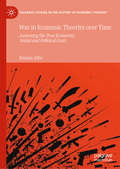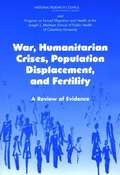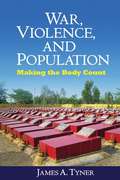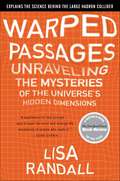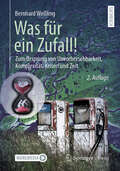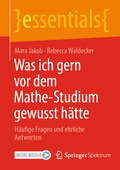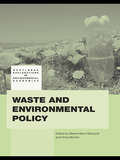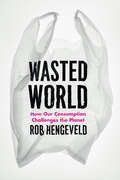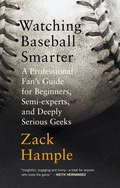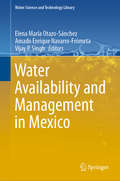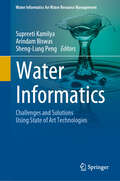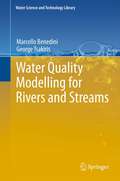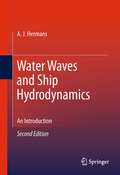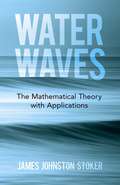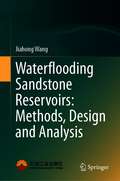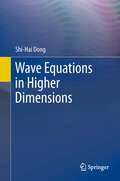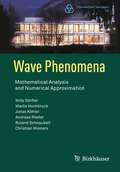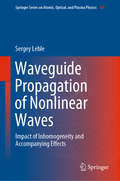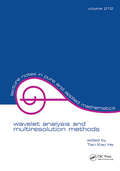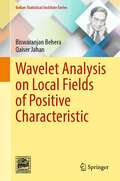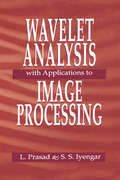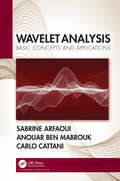- Table View
- List View
War in Economic Theories over Time: Assessing the True Economic, Social and Political Costs (Palgrave Studies in the History of Economic Thought)
by Renata AllioThis book offers the first systematic analysis of economic thought concerning war. It retraces debates on war from the formation of European states, the rise of Mercantilism, to Colonialism, Imperialism, the World Wars and the Cold War. Allio shows different economic perspectives from which it is possible to study war as a tool to achieve economic ends: causes, consequences, costs, funding methods, and effects on the economic status of the state and on the well-being of citizens. Examining interpretations from Smith, Hobson, Keynes, Kalecki, Stiglitz and many more, this important volume addresses the economic implications of war from the perspectives of many who bore the costs of wars in reality.
War, Humanitarian Crises, Population Displacement, and Fertility: A Review of Evidence
by Kenneth HillIncludes statistical data.
War, Violence, and Population
by James TynerGrounded in theory and research, this book offers a spatial perspective on how and why populations are regulated and disciplined by mass violence and why these questions matter for scholars concerned about social justice. James Tyner focuses on how states and other actors use acts of brutality to manage, administer, and control space for political and economic purposes. He shows how demographic analyses of fertility, mortality, and migration cannot be complete without taking war and genocide into account. Stark, in-depth case studies provide a powerful and provocative basis for retheorizing population geography.
Warped Passages: Unraveling the Mysteries of the Universe's Hidden Dimensions
by Lisa RandallThe universe has many secrets. It may hide additional dimensions of space other than the familier three we recognize. There might even be another universe adjacent to ours, invisible and unattainable . . . for now.Warped Passages is a brilliantly readable and altogether exhilarating journey that tracks the arc of discovery from early twentieth-century physics to the razor's edge of modern scientific theory. One of the world's leading theoretical physicists, Lisa Randall provides astonishing scientific possibilities that, until recently, were restricted to the realm of science fiction. Unraveling the twisted threads of the most current debates on relativity, quantum mechanics, and gravity, she explores some of the most fundamental questions posed by Nature—taking us into the warped, hidden dimensions underpinning the universe we live in, demystifying the science of the myriad worlds that may exist just beyond our own.
Was für ein Zufall!: Zum Ursprung von Unvorhersehbarkeit, Komplexität, Krisen und Zeit
by Bernhard WeßlingWarum sind so viele Ereignisse nicht vorhersehbar, glückliche Zufälle ebensowenig wie Katastrophen? Erleben wir eine neue Zeit der Polykrise? Angeblich so schlimm wie noch nie dagewesen, ist das belegbar? Aber was genau sind Krisen eigentlich? Und was haben sie mit der Komplexität der Welt zu tun? Sehr einfach und verständlich beantwortet der Autor diese und weitere Fragen im unterhaltsamen Plauderton, unterlegt mit knallharten Fakten, Daten und Berechnungen. Diese 2. und umfassend erweiterte Auflage ist im besten Sinne ein populärwissenschaftliches Buch und mischt sich zugleich in aktuelle gesellschaftliche Debatten ein: Wie können wir nachhaltig mit der Klimakrise umgehen? Nachhaltig nicht als leere Phrase. Denn Nachhaltigkeit kann objektiv beurteilt werden! Aber nach welchen Kriterien? Dazu entführt uns Bernhard Weßling auf eine Entdeckungsreise zu neuesten Erkenntnissen der modernen Chemie, Quantenphysik, Biologie und Kosmologie. Auf der Grundlage anerkannter Naturgesetze konfrontiert er uns mit neuen überraschenden Gedanken: Zufall, Komplexität und Krisen sind miteinander verwandt – gemeinsame Wurzel ist die Entropie. Sie erweist sich als lebensnah verständlich und sinnvoll anwendbar. Und ganz passend leitet der Autor daraus eine bestechende Hypothese ab zu der Menschheitsfrage: Was ist die Zeit?
Was für ein Zufall!: Über Unvorhersehbarkeit, Komplexität und das Wesen der Zeit
by Bernhard WeßlingWie kommt der Zufall in unsere Welt? Und warum ist so vieles nicht vorhersehbar?Verständlich, spannend und amüsant erzählend entführt uns der Autor in die Welt der Chemie, Quantenphysik und Biologie. Die Astronomie und Philosophie streifend, werden wir Zeugen einer lohnenden Entdeckungsreise. Dabei entwickelt er auf der Basis der Naturgesetze eine vollkommen neue Sicht auf den Zufall. Hierbei spielt das allgegenwärtige Nicht-Gleichgewicht eine überaus entscheidende Rolle, weil es die komplexen Strukturen in unserer Welt erzeugt. Abschließend präsentiert er auf dieser Grundlage eine gleichermaßen einfache wie bestechende Hypothese zum Wesen der Zeit.Dieses Sachbuch gibt einen tiefen Einblick in die Faszination der Forschung, in die quälende Suche nach grundlegendem Verständnis und das Ringen um wissenschaftliche Erkenntnis.
Was geht mich die Physik an?: Physikalisch denken in Gesellschaft, Politik und Management.
by Reiner KreePolitische Themen mit wissenschaftlichem Bezug werden medial immer präsenter. In Talkshows, Zeitungen und politischen Beratungsgremien finden oft Expertinnen und Experten mit Physikausbildung Gehör. Egal, ob es um Klimawandel, Finanzmarktcrashs, Pandemiepolitik oder erneuerbare Energien geht: wir müssen den Aussagen dieser Expertinnen und Experten blind vertrauen, wenn wir selbst kein Fachwissen besitzen. In diesem Buch werden physikalische Grundlagen hinter gesellschaftlich relevanten Themen auf eine allgemeinverständliche Weise erklärt. Dabei geht es vor allem darum, die für die Physik typischen Denkweisen klar zu machen. Auf welchen Grundlagen (Mechanik, Elektrodynamik, Quantentheorie, Feldtheorien, Relativitätstheorien, Statistische Physik) beruhen eigentlich physikalische Aussagen? Wie sind diese Grundlagen entstanden? Wie erstellt man in der Physik Modelle zur Beschreibung komplexer Themen? Was ist „Wahrheit" in Wissenschaften? Wie ist das Verhältnis von Modellen zur Wirklichkeit? Beim Beantworten dieser und vieler weiterer Fragen hat der Autor darauf geachtet, nur Mathematik vorauszusetzen, die das Niveau der Mittelstufe nicht überschreitet. Der vorliegende Band richtet sich an alle, die für Entscheidungen und Urteile ein einfaches aber solides Verständnis des physikalischen Denkens suchen: sei es im Alltag, in Unternehmen oder in der Politik.
Was ich gern vor dem Mathe-Studium gewusst hätte: Häufige Fragen und ehrliche Antworten (essentials)
by Rebecca Waldecker Mara JakobDieses Büchlein richtet sich an alle, die an einem Mathe-Studium im deutschsprachigen Raum interessiert sind oder bereits mittendrin stecken. Es hilft Ihnen, gute Entscheidungen zu treffen, bewahrt Sie vor einigen unangenehmen Überraschungen und erleichtert Ihnen den Einstieg ins Mathe-Studium. Zugegeben: Der Einstieg in ein Mathe-Studium verlangt viel. Nach ein paar Semestern gelingt den meisten jedoch mit Leichtigkeit, was am Anfang ungewohnt war und schwerfiel. „Wieso wurde mir das nicht gleich am Anfang gesagt?“ fragt sich dann der eine oder die andere. Deshalb verraten wir schon vorher, was im Mathe-Studium wichtig ist und was Sie dort erwartet. Im Text dieses Büchleins und im dazugehörigen Audio-Angebot liefern wir Antworten auf Fragen wie: Was passiert in einer Mathe-Vorlesung und was sind Übungsserien? Wieso brauche ich meistens keinen Taschenrechner? Ist so ein Studium nur etwas für Nerds? Und was ist eigentlich ein Lemma?
Waste and Environmental Policy (Routledge Explorations in Environmental Economics #Vol. 15)
by Massimiliano Mazzanti Anna MontiniThis research deals with the increasingly complex issues of waste generation, waste management and waste disposal that in less developed industrialised countries present diverse but critical concerns. It takes a socio-economic and policy-oriented perspective and provides empirical evidence at EU and regional level. The EU and Italy are taken as relevant case studies given the disparities in environmental performances between less and more developed areas. The rich and various empirical evidence shows that a robust delinking between waste generation and economic growth is still not present, thus future policies should directly address the problem at the source by targeting waste generation in EU countries. Some structural factors like population density and urbanisation present themselves as relevant drivers of both waste management and landfill diversion. Nevertheless, economic and structural factors alone are not sufficient to improve waste performances. Though waste policies are to be redesigned by covering the entire area of waste management, some first signals of policy effectiveness are arising. This work will be of most interest to those students of environmental economics and environmental sciences, as well as policy makers, waste utility managers and companies in the waste management sector.
Wasted World: How Our Consumption Challenges the Planet
by Rob HengeveldAll systems produce waste as part of a cycle--bacteria, humans, combustion engines, even one as large and complex as a city. To some extent, this waste can be absorbed, processed, or recycled--though never completely. In Wasted World, Rob Hengeveld reveals how a long history of human consumption has left our world drowning in this waste. This is a compelling and urgent work that traces the related histories of population growth and resource consumption. As Hengeveld explains, human life (and population growth) depends not only on mineral resources but also on energy. People first obtained energy from food and later supplemented this with energy from water, wind, and animals as one source after another fell short of our ever-growing needs. Finally, we turned to fossil energy, which generates atmospheric waste that is the key driver of global climate change. The effects of this climate change are already leading to food shortages and social collapse in some parts of the world. Because all of these problems are interconnected, Hengeveld argues strenuously that measures to counter individual problems cannot work. Instead, we need to tackle their common cause--our staggering population growth. While many scientists agree that population growth is one of the most critical issues pressuring the environment, Hengeveld is unique in his insistence on turning our attention to the waste such growth leaves in its wake and to the increasing demands of our global society. A practical look at the sustainability of our planet from the perspective of a biologist whose expertise is in the abundances and distributions of species, Wasted World presents a fascinating picture of the whole process of using, wasting, and exhausting energy and material resources. And by elucidating the complexity of the causes of our current global state, Hengeveld offers us a way forward.
Watching Baseball Smarter
by Zack HampleWhether you’re a major league couch potato, life-long season ticket-holder, or teaching game to a beginner,Watching Baseball Smarterleaves no territory uncovered. In this smart and funny fan’s guide Hample explains the ins and outs of pitching, hitting, running, and fielding, while offering insider trivia and anecdotes that will surprise even the most informed viewers of our national pastime. What is the difference between a slider and a curveball? At which stadium did “The Wave” first make an appearance? How do some hitters use iPods to improve their skills? Which positions are neverplayed by lefties? Why do some players urinate on their hands? Combining the narrative voice and attitude of Michael Lewis with the compulsive brilliance ofSchott’s Miscellany,Watching Baseball Smarterwill increase your understanding and enjoyment of the sport–no matter what your level of expertise. Zack Hample is an obsessed fan and a regular writer for minorleaguebaseball. com. He's collected nearly 3,000 baseballs from major league games and has appeared on dozens of TV and radio shows. His first book,How to Snag Major League Baseballs,was published in 1999.
Water Availability and Management in Mexico (Water Science and Technology Library #999)
by Vijay P. Singh Amado Enrique Navarro-Frómeta Elena María Otazo-SánchezThis book presents several complex case studies related to water management and planning in the context of pollution, growing demands, and global climate change in Mexico, but which are also relevant for other countries in Latin America. These concerns are of critical importance for policymakers who are coping with multiple conflicting interests. Water availability in Mexico is polarized, with abundant rainfall and large rivers in the south, and desert-like conditions in the north. The central region, which is the most industrialized, is overpopulated. Mexico City pours millions of cubic meters of “blackwater” into the northern valley daily and receives its clean water from the south. To address these unsustainable conditions, the world's 4th biggest water treatment plant went into operation in 2018. The water infrastructure and governance must satisfy the demands of all sectors, including agricultural, urban, and economic activities. At the same time, water resources are affected by drought, and climate change puts constraints on the supply. As such, regulation and monitoring are important when it comes to adherence to agreed plans and priorities. The book is divided into four sections. 1: Water Availability discusses quantitative aspects, such as supply, methods of calculation, and fracking. 2: Water Quality highlights pollution risks and diagnosis of water resources. 3: Water Allocation examines the sectoral demands and vulnerability due to unsustainable irrigation. 4: Water Governance and Management focuses on laws, urban rules, national parks, planning, and integrated water resources management, among other topics. The chapters include illustrative case studies in Mexico, such as basins, cities, reservoirs, and aquifers, water supply demand assessment, planning, and management.
Water Histories and Spatial Archaeology
by Michael J. HarrowerThis book offers a new interpretation of the spatial-political-environmental dynamics of water and irrigation in long-term histories of arid regions. It compares ancient Southwest Arabia (3500 BC–AD 600) with the American West (2000 BC–AD 1950) in global context to illustrate similarities and differences among environmental, cultural, political, and religious dynamics of water. It combines archaeological exploration and field studies of farming in Yemen with social theory and spatial technologies, including satellite imagery, Global Positioning System (GPS), and Geographic Information Systems (GIS) mapping. In both ancient Yemen and the American West, agricultural production focused not where rain-fed agriculture was possible, but in hyper-arid areas where massive state-constructed irrigation schemes politically and ideologically validated state sovereignty. While shaped by profound differences and contingencies, ancient Yemen and the American West are mutually informative in clarifying human geographies of water that are important to understandings of America, Arabia, and contemporary conflicts between civilizations deemed East and West.
Water Informatics: Challenges and Solutions Using State of Art Technologies (Water Informatics for Water Resource Management)
by Arindam Biswas Sheng-Lung Peng Supreeti KamilyaThis book provides a clear view of various applications for water resource management using different state-of-the-art technologies such as artificial intelligence, IoT, and cellular automata. The book also shows the analytical part of surface water as well as groundwater bodies to control pollution and save ecology. It gives an idea about the collection of data for disaster management such as flood prediction and flood inoculation. The book provides the fundamental aspects of various computational or simulation methods for surface and underground water body detection, prediction of non-biodegradable elements in water bodies, water potability, and predictions of natural disasters like floods. The book summarizes different aspects of water body challenges and the possible solutions proposed using new technologies. The book opens up a future research direction of dealing with various challenges and solutions based on emerging technologies. This book comes up with a direction for the researchers interested in dealing with various aspects of water challenges and finding solutions using emerging technologies in the new era of modern computations.
Water Quality Modelling for Rivers and Streams
by George Tsakiris Marcello BenediniThe main objective of the Water Framework Directive in the European countries is to achieve a "good status" of all the water bodies, in the integrated management of river basins. In order to assess the impact of improvement measures, water quality models are necessary. During the previous decades the progress in computer technology and computational methods has supported the development of advanced mathematical models for pollutant transport in rivers and streams. This book is intended to provide the fundamental knowledge needed for a deeper understanding of these models and the development of new ones, which will fulfil future quality requirements in water resources management. This book focuses on the fundamentals of computational techniques required in water quality modelling. Advection, dispersion and concentrated sources or sinks of contaminants lead to the formulation of the fundamental differential equation of pollutant transport. Its integration, according to appropriate initial and boundary conditions and with the knowledge of the velocity field, allows for pollutant behaviour to be assessed in the entire water body. An analytical integration is convenient only in one-dimensional approach with considerable simplification. Integration in the numerical field is useful for taking into account particular aspects of water body and pollutants. To ensure their reliability, the models require accurate calibration and validation, based on proper data, taken from direct measurements. In addition, sensitivity and uncertainty analysis are also of utmost importance. All the above items are discussed in detail in the 21 chapters of the book, which is written in a didactic form for professionals and students.
Water Waves and Ship Hydrodynamics: An Introduction
by A. J. HermansIn this book an introduction is given to aspects of water waves that play a role in ship hydrodynamics and offshore engineering. At first the equations and linearized boundary conditions are derived describing the non-viscous free surface water waves, with special attention to the combination of steady and non-steady flow fields. Then some simple kinds of free wave solutions are derived, such as plane waves and cylindrical waves. For several situations, steady and unsteady, the source singularity function is derived. These functions play a role in numerical codes used to describe the motion of ships and offshore structures. These codes are mostly based on a boundary integral formulation; therefore we give an introduction to these methods. It is shown how first order ship motions can be determined. In offshore engineering the second order wave drift motions play an important role. An introduction to this phenomenon is given and the effects which have to be taken into account are explained by means of a simple example where we can determine nearly all the aspects analytically. An interesting example that is worked out is the motion of very large floating flexible platforms with finite draft. Finally an introduction to the theory of shallow water non-linear dispersive waves is presented, and shallow water ship hydrodynamics, that plays a role in coastal areas and channels is treated. Here attention is paid to the interaction between passing ships in restricted water. In the appendix a short introduction to some of the mathematical tools is given.
Water Waves: The Mathematical Theory With Applications (Dover Books on Physics)
by James Johnston StokerFirst published in 1957, this is a classic monograph in the area of applied mathematics. It offers a connected account of the mathematical theory of wave motion in a liquid with a free surface and subjected to gravitational and other forces, together with applications to a wide variety of concrete physical problems. A never-surpassed text, it remains of permanent value to a wide range of scientists and engineers concerned with problems in fluid mechanics.The four-part treatment begins with a presentation of the derivation of the basic hydrodynamic theory for non-viscous incompressible fluids and a description of the two principal approximate theories that form the basis for the rest of the book. The second section centers on the approximate theory that results from small-amplitude wave motions. A consideration of problems involving waves in shallow water follows, and the text concludes with a selection of problems solved in terms of the exact theory. Despite the diversity of its topics, this text offers a unified, readable, and largely self-contained treatment.
Waterflooding Sandstone Reservoirs: Methods, Design and Analysis
by Jiahong WangThis book focuses on oilfield performance analysis and development adjustment by integrating geology, applied mathematics, and other relevant theories. Based on the abundant and detailed field test and production data from Daqing and Tarim, two major oilfields in China, the regularities, characteristics, design, and adjustment of waterflooding development of sandstone reservoirs throughout the life cycle are described. Field development theories and practices are organically combined in this book, which, embracing comprehensive, systematic, and pragmatic contents, is conducive to development technicians to quickly grasp the characteristics of waterflooding and prepare adjustment plans. It is also useful as a textbook in petroleum colleges and short training courses.
Wave Equations in Higher Dimensions
by Shi-Hai DongHigher dimensional theories have attracted much attention because they make it possible to reduce much of physics in a concise, elegant fashion that unifies the two great theories of the 20th century: Quantum Theory and Relativity. This book provides an elementary description of quantum wave equations in higher dimensions at an advanced level so as to put all current mathematical and physical concepts and techniques at the reader's disposal. A comprehensive description of quantum wave equations in higher dimensions and their broad range of applications in quantum mechanics is provided, which complements the traditional coverage found in the existing quantum mechanics textbooks and gives scientists a fresh outlook on quantum systems in all branches of physics. In Parts I and II the basic properties of the SO(n) group are reviewed and basic theories and techniques related to wave equations in higher dimensions are introduced. Parts III and IV cover important quantum systems in the framework of non-relativistic and relativistic quantum mechanics in terms of the theories presented in Part II. In particular, the Levinson theorem and the generalized hypervirial theorem in higher dimensions, the Schrödinger equation with position-dependent mass and the Kaluza-Klein theory in higher dimensions are investigated. In this context, the dependence of the energy levels on the dimension is shown. Finally, Part V contains conclusions, outlooks and an extensive bibliography.
Wave Phenomena: Mathematical Analysis and Numerical Approximation (Oberwolfach Seminars #49)
by Willy Dörfler Marlis Hochbruck Andreas Rieder Roland Schnaubelt Christian Wieners Jonas KöhlerThis book presents the notes from the seminar on wave phenomena given in 2019 at the Mathematical Research Center in Oberwolfach.The research on wave-type problems is a fascinating and emerging field in mathematical research with many challenging applications in sciences and engineering. Profound investigations on waves require a strong interaction of several mathematical disciplines including functional analysis, partial differential equations, mathematical modeling, mathematical physics, numerical analysis, and scientific computing.The goal of this book is to present a comprehensive introduction to the research on wave phenomena. Starting with basic models for acoustic, elastic, and electro-magnetic waves, topics such as the existence of solutions for linear and some nonlinear material laws, efficient discretizations and solution methods in space and time, and the application to inverse parameter identification problems are covered. The aim of this book is to intertwine analysis and numerical mathematics for wave-type problems promoting thus cooperative research projects in this field.
Waveguide Propagation of Nonlinear Waves: Impact of Inhomogeneity and Accompanying Effects (Springer Series on Atomic, Optical, and Plasma Physics #109)
by Sergey LebleThis book addresses the peculiarities of nonlinear wave propagation in waveguides and explains how the stratification depends on the waveguide and confinement. An example of this is an optical fibre that does not allow light to pass through a density jump. The book also discusses propagation in the nonlinear regime, which is characterized by a specific waveform and amplitude, to demonstrate so-called solitonic behaviour. In this case, a wave may be strongly localized, and propagates with a weak change in shape. In the waveguide case there are additional contributions of dispersion originating from boundary or asymptotic conditions.Offering concrete guidance on solving application problems, this essentially (more than twice) expanded second edition includes various aspects of guided propagation of nonlinear waves as well as new topics like solitonic behaviour of one-mode and multi-mode excitation and propagation and plasma waveguides, propagation peculiarities of electromagnetic waves in metamaterials, new types of dispersion, dissipation, electromagnetic waveguides, planetary waves and plasma waves interaction.The key feature of the solitonic behaviour is based on Coupled KdV and Coupled NS systems. The systems are derived in this book and solved numerically with the proof of stability and convergence. The domain wall dynamics of ferromagnetic microwaveguides and Bloch waves in nano-waveguides are also included with some problems of magnetic momentum and charge transport.
Wavelet Analysis and Multiresolution Methods (Lecture Notes in Pure and Applied Mathematics)
by Tian-Xiao HeThis volume contains papers selected from the Wavelet Analysis and Multiresolution Methods Session of the AMS meeting held at the University of Illinois at Urbana-Champaign. The contributions cover: construction, analysis, computation and application of multiwavelets; scaling vectors; nonhomogenous refinement; mulivariate orthogonal and biorthogona
Wavelet Analysis on Local Fields of Positive Characteristic (Indian Statistical Institute Series)
by Biswaranjan Behera Qaiser JahanThis book discusses the theory of wavelets on local fields of positive characteristic. The discussion starts with a thorough introduction to topological groups and local fields. It then provides a proof of the existence and uniqueness of Haar measures on locally compact groups. It later gives several examples of locally compact groups and describes their Haar measures. The book focuses on multiresolution analysis and wavelets on a local field of positive characteristic. It provides characterizations of various functions associated with wavelet analysis such as scaling functions, wavelets, MRA-wavelets and low-pass filters. Many other concepts which are discussed in details are biorthogonal wavelets, wavelet packets, affine and quasi-affine frames, MSF multiwavelets, multiwavelet sets, generalized scaling sets, scaling sets, unconditional basis properties of wavelets and shift invariant spaces.
Wavelet Analysis with Applications to Image Processing
by S. Sitharama Iyengar Lakshman PrasadWavelet analysis is among the newest additions to the arsenals of mathematicians, scientists, and engineers, and offers common solutions to diverse problems. However, students and professionals in some areas of engineering and science, intimidated by the mathematical background necessary to explore this subject, have been unable to use this powerful tool.The first book on the topic for readers with minimal mathematical backgrounds, Wavelet Analysis with Applications to Image Processing provides a thorough introduction to wavelets with applications in image processing. Unlike most other works on this subject, which are often collections of papers or research advances, this book offers students and researchers without an extensive math background a step-by-step introduction to the power of wavelet transforms and applications to image processing.The first four chapters introduce the basic topics of analysis that are vital to understanding the mathematics of wavelet transforms. Subsequent chapters build on the information presented earlier to cover the major themes of wavelet analysis and its applications to image processing. This is an ideal introduction to the subject for students, and a valuable reference guide for professionals working in image processing.
Wavelet Analysis: Basic Concepts and Applications
by Sabrine Arfaoui Anouar Ben Mabrouk Carlo CattaniWavelet Analysis: Basic Concepts and Applications provides a basic and self-contained introduction to the ideas underpinning wavelet theory and its diverse applications. This book is suitable for master’s or PhD students, senior researchers, or scientists working in industrial settings, where wavelets are used to model real-world phenomena and data needs (such as finance, medicine, engineering, transport, images, signals, etc.). Features: Offers a self-contained discussion of wavelet theory Suitable for a wide audience of post-graduate students, researchers, practitioners, and theorists Provides researchers with detailed proofs Provides guides for readers to help them understand and practice wavelet analysis in different areas
